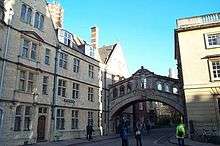Thomas Graham Jackson
| Thomas Graham Jackson | |
|---|---|
 | |
| Born |
21 December 1835 London |
| Died | 17 November 1924 (aged 88) |
| Occupation | Architect |
| Awards | Royal Gold Medal (1910) |
Sir Thomas Graham Jackson, 1st Baronet RA (21 December 1835 – 7 November 1924) was one of the most distinguished English architects of his generation. He is best remembered for his work at Oxford for Oxford Military College as well as the University, notably: the Examination Schools, most of Hertford College (including the Bridge of Sighs over New College Lane), much of Brasenose College, a range at Trinity College, and the Acland Nursing Home in North Oxford. Much of his career was devoted to the architecture of education and he worked extensively for various schools, notably Giggleswick and his own alma mater Brighton College. Jackson designed the former town hall in Tipperary Town, Ireland. He also worked on many parish churches and the college chapel at the University of Wales, Lampeter. He is also famous for designing the chapel (amongst other things) at Radley College. The City of Oxford High School in George Street, Oxford was another building designed by him.

He was educated at Brighton College and then Wadham College, Oxford,[1] of which he wrote a history, before being articled as a pupil to Sir George Gilbert Scott.
Jackson was a prolific author of carefully researched works in architectural history, often illustrated with sketches made during his extensive travels.
He and Norman Shaw edited "Architecture, A Profession or an Art" published in 1892, to which William H. White replied by publishing "The Architect and his artists, an essay to assist the public in considering the question is architecture a profession or an art".
This had been part of the course of events which resulted in the passing of the Architects (Registration) Acts, 1931 to 1938 which established the statutory Register of Architects and monopolistic restrictions on the use of the vernacular word "architect", imposed with threat of penalty on prosecution for infringement.
In 1919, Jackson wrote a collection of supernatural stories, Six Ghost Stories. These stories were written under the influence of M. R. James, and Jackson expressed admiration for James' work in the book's introduction.[2][3]
A stone memorial tablet to Sir Thomas was erected in the chapel of Brighton College, part of which he had built as a First World War memorial in 1922–23. For that school's chapel he had also designed many memorials during the 1880s and 1890s. The other concentrated group of mural tablets by Jackson is to be found in the antechapel of Wadham College in Oxford.
Jackson's pupils and assistants included Evelyn Hellicar.
Jackson was created a Baronet, of Eagle House in Wimbledon in Surrey, in 1913.
Sources
| Wikisource has original text related to this article: |
- Jackson, Thomas Graham (2003). Nicholas Jackson, ed. Recollections: The life and travels of a Victorian architect. James Bettley. London: Unicorn Press. ISBN 0-906290-72-4.
- Jones, Martin D.W. (1991). Gothic Enriched: Thomas Jackson's Mural Tablets in Brighton College Chapel in Church Monuments VI. pp. 54–66.
- Kidd, Charles; Williamson, David, eds. (1990). Debrett's Peerage and Baronetage (1990 Edition). New York: St. Martin's Press.
- Leigh Rayment's list of baronets
- Whyte, William (2006). Oxford Jackson: Architecture, education, status, and style, 1835–1924. Oxford: Clarendon Press. ISBN 0-19-929658-8.
References
- ↑ "JACKSON, Thomas Graham". Who's Who. Vol. 59. 1907. p. 921.
- ↑ Neil Wilson, Shadows in the Attic: A Guide to British supernatural fiction, 1820-1950 London, British Library. 2000 ISBN 0712310746. (p.278-9)
- ↑ Ramsey Campbell(ed.) Meddling with Ghosts: Stories in the Tradition of M. R. James. London, British Library. ISBN 978-0-7123-1125-0, 2001. (pp.101, 277)
External links
![]() Media related to Thomas Graham Jackson at Wikimedia Commons
Media related to Thomas Graham Jackson at Wikimedia Commons
| Baronetage of the United Kingdom | ||
|---|---|---|
| Preceded by New creation |
Baronet (of Eagle House) 1913–1924 |
Succeeded by Hugh Nicholas Jackson |